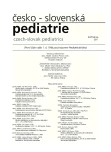Do we treate patients with cryptorchism at the recommended age?
Authors:
D. Albertová; M. Drlík; P. Havránek
Authors place of work:
Klinika dětské chirurgie a traumatologie 3. LF UK a FTNsP, Praha
přednosta prof. MUDr. P. Havránek, CSc.
Published in the journal:
Čes-slov Pediat 2011; 66 (2): 79-84.
Category:
Původní práce
Summary
Boys with cryptorchism should be treated, according to the recommendation of the European Urological Society, treated up to 18 months of age. In spite of that numerous patients are operated on at later periods of time.
The aim of the study was to find out, how is the recommendation observed and reasons, why the part of the patients is operated on later. The results of the evaluation of our cohort indicate a continuing low awareness of the more stringent requirements for the time of the treatment. The hormonal therapy should not follow to delay of surgical therapy of cryptorchism. The ascensus of testis is not a rare disease. It is therefore necessary, within the framework of obligatory preventive examination, to examine the position of testis in scrotum.
Key words:
cryptorchism, orchidopexis, ascensus of testis
Zdroje
1. Kočvara R. Kryptorchizmus: kdy načasovat a jakou léčbu provést? Urol List 2007; 5(1): 30–33.
2. Zeman L. Retence varlete. In: Šnajdauf J, Škába R. Dětská chirurgie. Praha: Karolinum, 2005: 272–276.
3. Huff DS, Hadziselimovic, Snyder HM 3rd, et al. Histologic maldevelopment of unilaterally kryptorchid testes and thein descended partners. J Eur Pediatr 1993;152 (Suppl 2): S11–14.
4. Tekgül S, Riedmiller H, Gerharz E, et al. Guidelines of pediatric urology. In: European Association of Urology Guidelines. EAU, 2009: 9.
5. Wood HM, Doder JS. Cryptorchidism and testicular cancer: separating fact from fiction. J Urol 2009; 181(2): 452–461.
6. Stec AA, Thomas JC, DeMarco RT, et al. Incidence of testicular ascent in boys with retractile testes. J Urol. 2007 Oct; 178(4 Pt 2): 1722–1724.
7. Mesrobian HG, Chassaignac JM, Laud PW. Presence or absence of an impalpable testi can be predicted from clinical observations alone. BJU Int 2002; 90(1): 97–99.
8. Lisá L. Nesestouplá varlata. Čes-slov Pediat 1996; 51: 235–237.
9. Pyorala S, Huttunen NP, Ujati M. A review and meta-analysis of hormonal treatment of cryptorchidism. J Clin Endocrinol Metab 1995; 80: 2795–2799.
10. Hadziselimovic F. Successful treatment of unilateral kryptorchid boys risking infertility with LH-RH analogue. Int Braz J Urol 2008 May–Jun; 34(3): 319–326.
11. Teyschl O, Tůma J. Využití laparoskopie při diagnostice, klasifikaci a léčbě nehmatného nesestouplého varlete. Rozhl Chir 2000; 79(11): 557–560.
12. Barthold JS, González R. The epidemiology of congenital cryptorchidism, testicular ascent and orchiopexy. J Urol. 2003 Dec; 170(6 Pt 1): 2396–2401.
Štítky
Neonatologie Pediatrie Praktické lékařství pro děti a dorostČlánek vyšel v časopise
Česko-slovenská pediatrie

2011 Číslo 2
- Horní limit denní dávky vitaminu D: Jaké množství je ještě bezpečné?
- Isoprinosin je bezpečný a účinný v léčbě pacientů s akutní respirační virovou infekcí
- Stillova choroba: vzácné a závažné systémové onemocnění
Nejčtenější v tomto čísle
- Vybrané kapitoly z nové učebnice Klinická pediatrie
- Extraezofágový reflux – otorinolaryngologické komplikácie gastroezofágového refluxu
- Léčíme pacienty s kryptorchismem v doporučeném věku?
- Krikofaryngeálna achalázia ako príčina chronického dráždivého kašľa u dojčaťa
